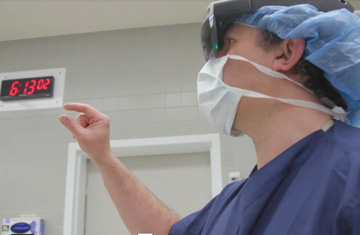Surgical navigation and AR have the potential to improve shoulder replacements, even if long-term clinical evidence for the burgeoning technologies is not yet available, according to Dr. Bell. “Anything that helps surgeons place implants
more accurately will have a positive effect on outcomes data,” he says.
“Surgeons place non-anatomic implants into an anatomic structure and change some of the surrounding anatomy,” says Dr. Khazzam, who recently used AR to reconstruct a patient’s shoulder with a 3D-printed glenoid baseplate
generated from a pre-op CT scan and computerized planning software. “We’re all chasing the restoration of the joint to as close to normal anatomy as possible. Navigation software allows us to be better at identifying potential
problem areas and improving implant placement based on factors such as thickness, width and offsets.”
Several studies have shown that computerized pre-op planning improves the accuracy of implant placement, according to Dr. Khazzam. He says AR advances the potential of the technology by allowing surgeons to seamlessly interact with the information
to confirm they’re performing surgery as well as they believe. Early functional outcomes — including range of motion and the patient’s ability to return to full activity — of AR-assisted shoulder replacements are
currently being studied.
Dr. Khazzam says artifical intelligence is in the infancy of being used to review patterns of high-volume surgeons who use navigation software, but the ongoing analysis of big data will eventually identify the best surgical approaches and
optimal positions for implants based on specific types of anatomy.
Advances in implant designs are also contributing to improved outcomes. Dr. Bell often uses stemless humeral implants for anatomic shoulder replacements. The implants, which have been popular in Europe for many years and are beginning to gain
traction in the U.S., require good bone density for implantation. “There are several theoretical advantages to using stemless implants,” explains Dr. Bell. “Although current studies don’t show that they improve
short-term outcomes, they could make replacements easier to revise 15 to 20 years after the primary surgery.”
Surgeons want to preserve as much bone as possible when placing implants, according to Dr. Khazzam, who says stemless implants let them accomplish that goal on the humeral side of the joint. “Stemless designs are allowing surgeons to
become accurate and precise in protecting more of the native bone and lessening issues related to stress shielding,” he adds. “Newer implants with porous surfaces also allow for bone integration into the metal, which can lead
to better fixation than implants secured with cement.”
The number of primary shoulder replacements, both anatomic and reverse, are increasing exponentially due to an aging patient population, says Dr. Khazzam. He also points to increasing numbers of young, fellowship-trained shoulder specialists
who are comfortable taking on complex cases as a contributing factor to the majority of procedures being performed on an outpatient basis.
“Overall rates of shoulder replacements are rising significantly,” says Dr. Bell, who performs about two-thirds of his procedures in the same-day setting. “It’s been proven to be a safe outpatient procedure for properly
selected patients.” OSM
.svg?sfvrsn=be606e78_3)

.svg?sfvrsn=56b2f850_5)